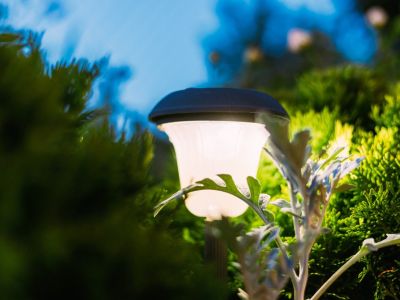Reasons to Light Up Raised Beds
Lighting a raised bed, especially a vegetable bed may be to simply add ambiance or may be for a more utilitarian purpose. Avid gardeners often find it difficult to find time to attend to their gardens either because they work late, or summer temperatures are too hot during the day. Installing raised bed lights solves the issue of time. It allows the gardener access to the vegetable or raised flower bed after the sun has gone down without cumbersome flashlights or headlamps. Outdoor lighting in or around a raised bed also allows the gardener to inspect for nighttime pests such as slugs or beetles or to see where the cat is hiding.
Five Types of Garden Bed Lighting
There is no one lighting solution for everyone. Your choice depends upon what your end goal is but basically there are five different lighting ideas to look at.
Task lighting is used for the reasons above. To give the gardener more time in the garden after the sun goes down.
Path lighting illuminates the way towards your raised beds eliminating tripping over the hose or tromping your prized dahlias.
Down lights are attached high up in trees, fencing or structures and cast a lovely moon kissed glow on the garden below.
Up lights brighten the garden after dark but also may be used to dramatically highlight areas of interest in the garden or details of your home. These are a great option for raised flower bed lighting near your home or other structure.
Lastly, motion sensor lights keep the boogie man at bay or any other intruder while allowing the gardener illumination to perform nighttime tasks. They also illuminate marauding deer or other critters in a split second.
Information on Outdoor Lighting
The simplest lighting options and one great for established gardens are solar lights. With solar lights there is no need to dig up any area of the garden to lay conduit. Solar lights are also fairly inexpensive. Depending upon your climate however, solar lights may have a short shelf life plus they have a rather dim illumination. If you would rather spend a bit more and don’t mind tunneling through the landscape, wiring sleeves or conduit is the way to go. This option works great for homeowners who are just starting the landscaping process since there won’t be valuable plants, turf or walkways that might need to be disturbed. Preplanning is necessary to install conduit under raised beds or sidewalks. Before installing conduit you may want to consult with a professional. You will need to call the phone number in your area to have the utility company come out and check for underground systems before you start digging. You may also need to check with your local municipality regarding property lines and whether a permit is required.
Licensed Electrician or Not?
The specifics of what you will need for lighting depends upon your choices, but most residential outdoor lighting uses a 120-volt outlet or circuit which is then converted to a 12 volt system through a transformer. This may mean hiring a licensed, bonded electrician. Most systems can run multiple units off the same wire. Twelve-gauge double wire is standard but 10 or 8 gauge may be used due to long wire runs or too many systems. An electrician may be needed to wire an outdoor receptacle and switch to control your new lighting system as well as establish a circuit and install fixtures.
Final Words on Raised Garden Bed Lights
An electrician is not always necessary. Big box stores and the like often sell electric lighting that can easily be installed by the homeowner it just depends on how much lighting you want, type of lights, existing power, etc. There are lots of outdoor options out there. Do your research and/or consult with a landscape architect to get the most out of your outdoor lighting needs.
